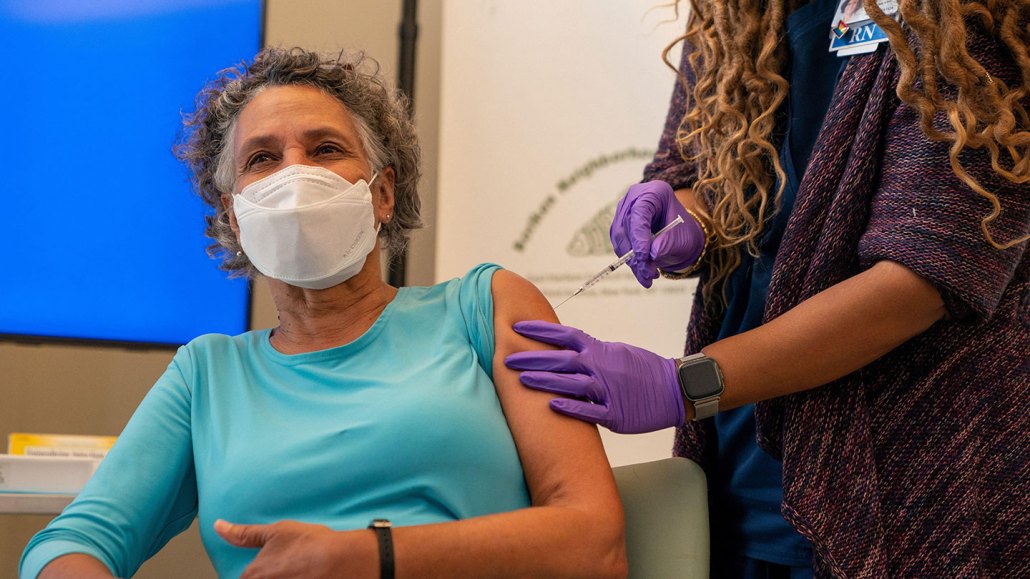How 4 major coronavirus tools impacted the pandemic in 2022
COVID-19 vaccines for the littlest kids and an updated booster marked Year Three of the pandemic

Mary Bassett, New York state’s Commissioner of Health, receives her updated booster in early September, soon after the shot was recommended. The booster was designed to spur an immune response against more versions of the virus.
Enrique Shore/Alamy Stock Photo
- More than 2 years ago
The third year of the COVID-19 pandemic in the United States introduced vaccines for very young children and an updated booster, plus wider availability of an antiviral drug and at-home antigen tests. Here’s what we’ve learned since these achievements first made a splash.
Shots for the littlest kids
On June 18, the COVID-19 vaccine was recommended for children under 5, the last group in the United States waiting for the shots (SN Online: 6/17/22). The thumbs-up was supported by immunity and safety data and the clear-and-present health risks of COVID-19 for young kids.
Update: Many young children in the United States are still unvaccinated. Only 11 percent of those 6 months through 4 years old, or 1.8 million children, had received at least one dose as of December 7. A survey from the Kaiser Family Foundation COVID-19 Vaccine Monitor conducted in mid-July explored some reasons for the lackluster response, including concerns that the vaccine hasn’t been tested enough.
There are also barriers to getting the vaccine, with 44 percent of Black parents worried about taking time off from work to vaccinate young kids or take care of them if they have side effects. Among Hispanic parents surveyed, 45 percent are concerned they won’t have the option to vaccinate at a place they trust.
A new booster
An updated COVID-19 vaccine became available as a booster in the United States in early September for those 12 and older, and for those 5 to 12 years old in mid-October (SN: 10/8/22 & 10/22/22, p. 7). The vaccine, which targets two omicron subvariants as well as the original version of SARS-CoV-2, was designed to spur a broader immune response, protecting against more versions of the virus.
Update: Just 13.5 percent of people in the United States ages 5 and older, or 42 million people, had gotten the updated bivalent booster by December 7. In a survey conducted in September, half of U.S. adults had heard little or nothing about the new booster, underscoring the need for more public outreach. President Joe Biden, who had COVID-19 in July, received his updated vaccine on October 25 and announced new measures to get more boosters into arms. A study of U.S. adults, reported in November, found that the updated booster provided added protection against symptomatic COVID-19 in those who had already gotten at least two doses of the original vaccine.
At-home COVID-19 tests
Early in 2022, the use of at-home COVID-19 tests soared in response to the winter omicron surge (SN Online: 1/11/22). From January to September, the Biden administration mailed roughly 600 million free tests to people’s homes.
Update: At-home antigen tests are quick and easy, though the guidance on how to interpret the results has changed. With data that repeat testing improved the chances of detecting a SARS-CoV-2 infection, the U.S. Food and Drug Administration recommended in August that people with and without symptoms who were exposed to the virus and tested negative take additional tests over the next several days.
A drawback to at-home tests is that the results have not been systematically tallied, leading to an undercount of cases. Estimates vary on how many cases have been missed. One research group calculated that in New York City between April 23 and May 8, around 1.5 million adults had COVID-19, nearly 30 times as many as the official case count of 51,218.
A new drug
The antiviral Paxlovid — authorized at the end of 2021 — became one of a few COVID-19 treatment options in pill form. A study published in April reported that Paxlovid reduced the risk of severe COVID-19 by 89 percent compared with a placebo (SN Online: 5/11/22).
Update: In July, the FDA authorized pharmacists to prescribe Paxlovid to get the drug more quickly to more people, since it needs to be taken early in an infection. A study conducted during the omicron surge suggested that the drug is beneficial for those 65 and older but is not helpful to those 40 to 64.
Paxlovid also made news this year when reports popped up of COVID-19 symptoms returning after treatment with the drug ended (SN Online: 8/12/22). It’s not clear how common so-called Paxlovid rebound is. Some research has found the incidence is similar among Paxlovid-treated and placebo-treated patients, while other researchers have reported that rebound occurs more often with Paxlovid than with no treatment.
There’s also early evidence that Paxlovid may reduce the risk of developing long COVID. A preliminary study of U.S. veterans reported in November that treatment with Paxlovid within five days of a positive COVID-19 test was associated with a 26 percent reduction in risk of long COVID compared with a group that did not receive antiviral treatment after an infection.







